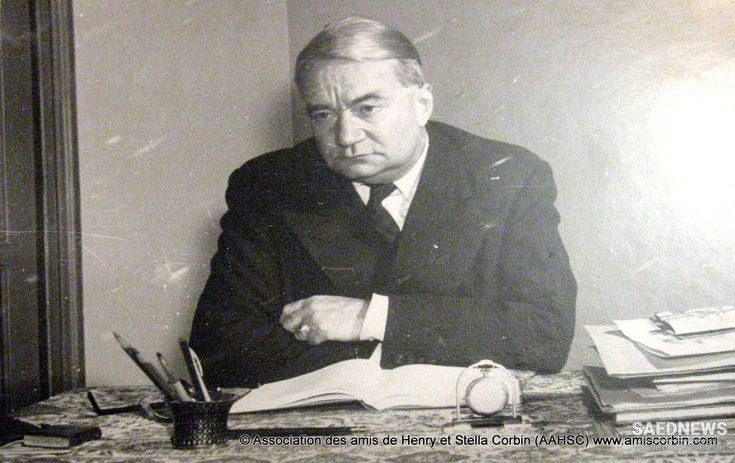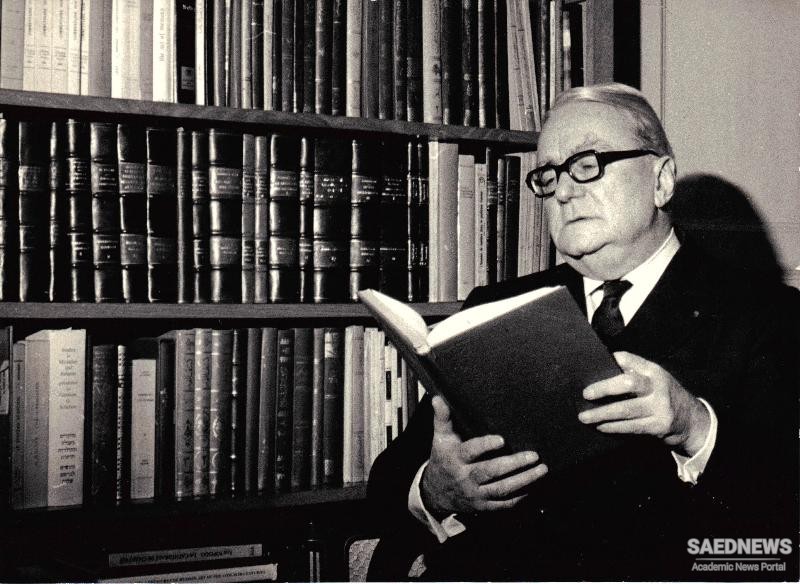Born into a Protestant family in Paris in April 1903, Corbin received a Catholic education, obtaining a certificate in Scholastic philosophy from the Catholic Institute of Paris at age 19. Three years later he took his "license de philosophie" under the Thomist thinker Étienne Gilson. He studied modern philosophy, including hermeneutics and phenomenology, becoming the first French translator of Martin Heidegger. In 1928, Louis Massignon (director of Islamic studies at the Sorbonne) introduced him to Suhrawardi, the 12th-century Persian Muslim thinker. In a late interview, Corbin said: "through my meeting with Suhrawardi, my spiritual destiny ... was sealed. Platonism, expressed in terms of the Zoroastrian angelology of ancient Persia, illuminated the path that I was seeking." He thus dedicated himself to understanding Iranian Islam, which he believed esoterically expressed older perennial insights related to Zoroastrianism and Platonism.
Corbin regularly spent time in Iran, working with Shia thinkers such as Muhammad Husayn Tabatabai and Seyyed Hossein Nasr. He also became prominent in the European Eranos circle of scholars initiated by Carl Jung, whose theories (such as the collective unconscious and active imagination) he appreciated. Aside from Islamic thought, Corbin wrote on Christian mysticism, especially Emanuel Swedenborg and the Holy Grail.
The philosophical life and career of Corbin can be divided into three phases. The first is the 1920s and 1930s, when he was involved in learning and teaching western philosophy. The second is the years between 1939 and 1946, in which he studied Shahab al-Din Suhrawardi and the School of Illumination in Istanbul. The last phase begins in 1946 and lasts until his death, in which he studied and reintroduced eastern and Islamic philosophy.
In 1933 he married Stella Leenhardt. In 1938, he completed the first translation of one of Heidegger's works into French (Was ist Metaphysik?, as Qu’est-ce que la metaphysique?). In 1939 they traveled to Istanbul, and in 1945 to Tehran. They returned to Paris one year later in July 1946. In 1949, Corbin first attended the annual Eranos Conferences in Ascona, Switzerland. In 1954 he succeeded Louis Massignon in the Chair of Islam and the Religions of Arabia at the École Pratique des Hautes Études in Paris. From the 1950s on he spent autumn in Tehran, winter in Paris and spring in Ascona.
The three major works upon which his reputation largely rests in the English speaking world were first published in French in the 1950s: Avicenna and the Visionary Recital, Creative Imagination in the Sufism of Ibn 'Arabi and Spiritual Body and Celestial Earth. His later major work on Central Asian and Iranian Sufism appears in English with an Introduction by Zia Inayat Khan as The Man of Light in Iranian Sufism. His magnum opus is the four volume En Islam Iranien: Aspects spirituels et philosophiques. It has been translated into Persian twice by Dr Enshollah Rahmati and Reza Kuhkan from French (the 4th volume being still untranslated). He died on 7 October 1978.

There are several main themes which together form the core of the spirituality that Corbin defends. The Imagination is the primary means to engage with Creation. Prayer is the "supreme act of the creative imagination". He considered himself a Protestant Christian but he abandoned a Christocentric view of history. The grand sweep of his theology of the Holy Spirit embraces Judaism, Christianity and Islam. He defended the central role assigned in theology for the individual as the finite image of the Unique Divine.
His mysticism is no world-denying asceticism but regards all of Creation as a theophany of the divine. This vision has much in common with what has become known as Creation Spirituality, and the figure of the Angel Holy Spirit is similar to what is sometimes called the Cosmic Christ.
Corbin's ideas have continued through colleagues, students and others influenced by his work. These include the following prolific scholars of Sufism and Islamic thought: Seyyed Hossein Nasr, William Chittick, Christian Jambet, Ali Amir-Moezzi, Hermann Landolt, Pierre Lory, James Cowan, James Morris, and Todd Lawson. In England his influence has been felt in the work of Kathleen Raine, Phillip Sherrard and other members of the Temenos Academy. Corbin was an important source for the archetypal psychology of James Hillman and others who have developed the psychology of Carl Jung. In addition, Corbin was good friends with Jacques Lacan, the French reinterpreter of Sigmund Freud, which gave Lacan a familiarity with Islamic thought. According to Behrooz Ghamari-Tabrizi, Michel Foucault’s Mystical understanding of Shia Islam which he utilised while reporting on the Iranian revolution was shaped by the scholarship of Louis Massignon and Henry Corbin. The American literary critic Harold Bloom claims Corbin as a significant influence on his own conception of Gnosticism, and the American poet Charles Olson was a student of Corbin's Avicenna and the Visionary Recital. Corbin's friends and colleagues in France have established L'Association des Amis de Henry et Stella Corbin[15] for the dissemination of his work through meetings and colloquia, and the publication of his posthumous writings.
Corbin's work has been criticized by a number of writers, including Steven M. Wasserstrom. Corbin's scholarly objectivity has been questioned on the basis of both a Shi'ite bias, and his theological agenda; he has been accused of being both ahistorically naive and dangerously politically reactionary; and he has been charged with being both an Iranian nationalist and an elitist in both his politics and his spirituality. Other writers, such as Lory and Subtelny, have written to defend Corbin.


 Patrice Lumumba the Messiah from Congo
Patrice Lumumba the Messiah from Congo













































